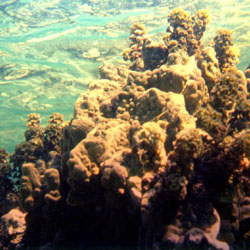Hannah Stewart

I am interested in marine benthic ecology. In particular, in the ecological implications of the interaction between water motion and morphology of benthic sessile organisms. Water motion affects most aspects of the life history of benthic organisms, but two factors -- mass transfer (of nutrients, gases and particles) and hydrodynamic forces -- influence organisms daily, and both interact with the morphology of organisms. Water motion facilitates delivery of essential gases and nutrients to the organism and removal of wastes from the proximity of the organism. The movement of water also imparts direct hydrodynamic forces on benthic organisms that may cause damage and dislodgement if these forces exceed the ability of the organism to resist them. Thus, the way in which organisms interacts with flow environments has diverse implications for their survival and fitness. Because morphology can be influenced both by mass transfer and hydrodyamic forces, it may represent a trade-off between maximizing mass transfer and minimizing the susceptibility to damage by hydrodynamic forces exerted by the flow environment.
My work will focus on how aspects of morphology affect, and are affected by water motion, focusing primarily on the morphological characteristic of flexibility. Using physical models in flow/wave tanks I will investigate the effects of degree of rigidity/flexibility and the shape of organisms on both mass transfer and forces across a range of different morphologies. Application of the principles established in the lab will then be investigated in the field, using the tropical reef alga Turbinaria ornata. T. ornata is a good organism for this study as it is not flexible, although its material properties vary across different flow regimes. It also is successful in tropical, oligotrophic water across flow regimes, and therefore might be expected to have a morphology that maximizes mass transfer.
Publications
- Stewart, H. L. (2004) Hydrodynamic consequences of maintaining an upright posture by different magnitudes of stiffness and buoyancy in the tropical alga Turbinaria ornata. Journal of Marine Systems 49: 157-167.
- Stewart, H. L. (2006) Ontogenetic changes in buoyancy, breaking strength, extensibility and reproductive investment in a drifting macroalga Turbinaria ornata. Journal of Phycology 42: 43-50.
- Stewart, H. L. (2006) Morphological variation and phenotypic plasticity of buoyancy in the macroalga Turbinaria ornata across a barrier reef. Marine Biology 149: 721-730
- Stewart, H. L. (2006) Hydrodynamic consequences of flexural stiffness and buoyancy for seaweeds: a study using physical models. Journal of Experimental Biology 209: 2170-2181.
- Stewart, H. L., C. E. Payri and M. A. R. Koehl. (2007) The role of buoyancy in mitigating reduced light interception for macroalgae in aggregations. Journal of Experimental Marine Biology and Ecology 343: 11-20.
